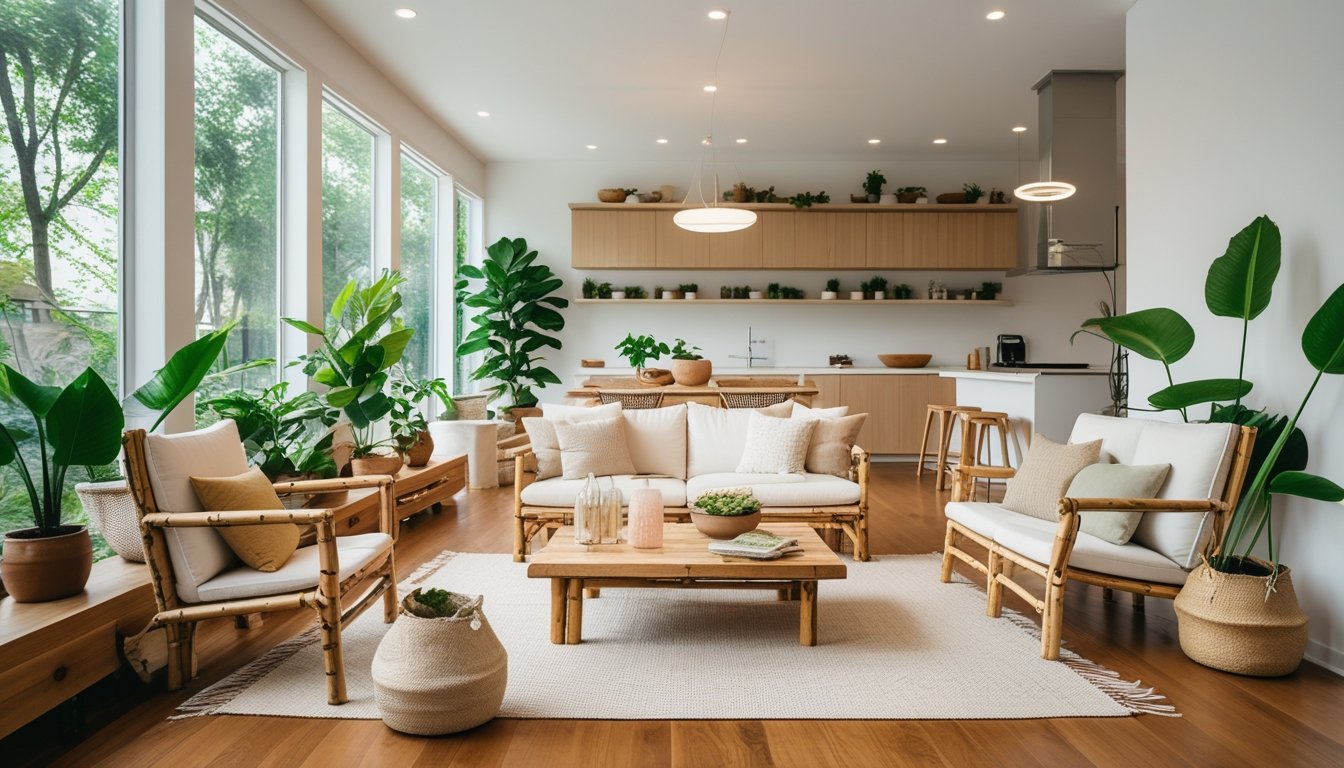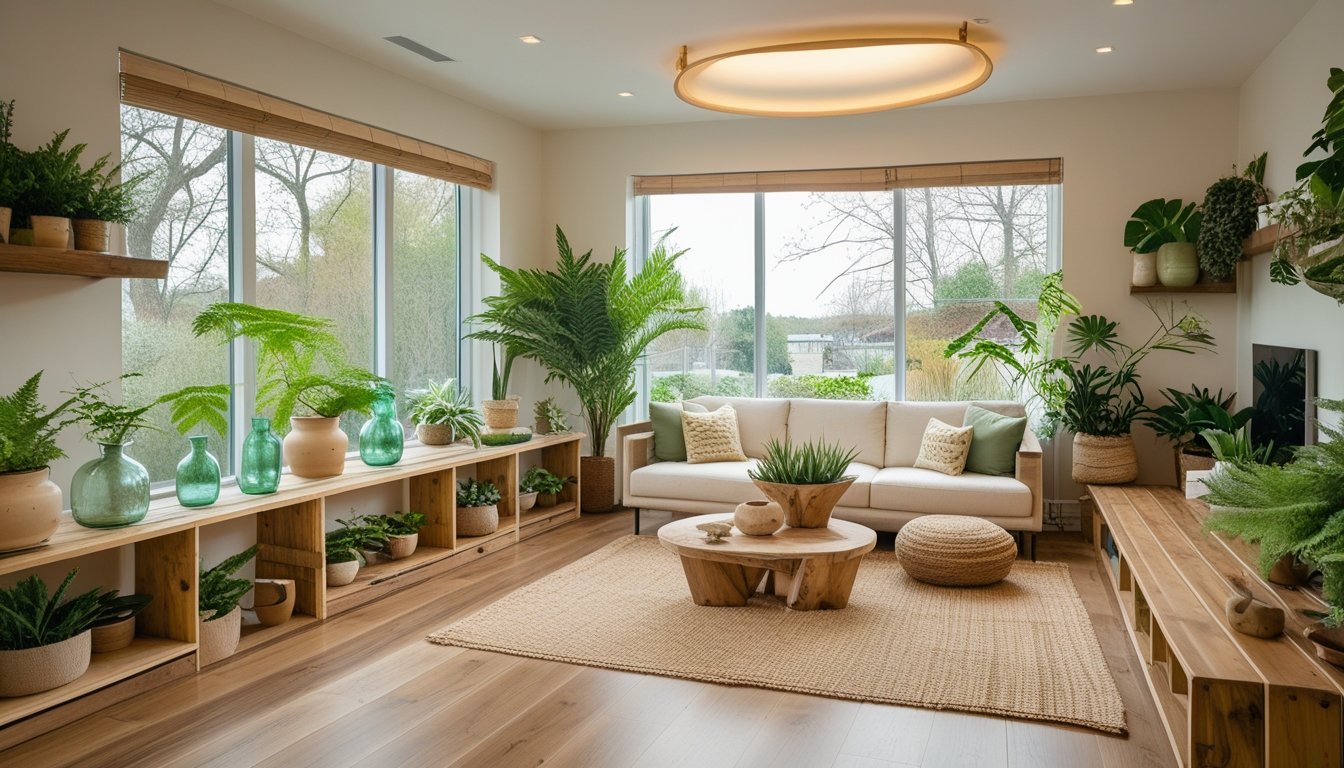Late updated: 18 Sep 2025 13:09
Written by: Sarah Hollister
Sustainable Interior Design Tips For Eco-Friendly Homes: Essential Strategies
Creating a home that's both chic and kind to the planet is more attainable than ever with sustainable interior design. As we become more conscious of our environment, the choices we make for our homes offer an impactful opportunity to contribute to a healthier planet. Opting for renewable materials such as bamboo flooring, recycled glass, and eco-friendly paints can significantly lower a home's carbon footprint while also creating a stylish and welcoming atmosphere.

By focusing on practical and creative solutions, we can transform our living spaces into eco-conscious havens. The integration of energy-efficient construction methods and smart technologies can drastically reduce the amount of energy we consume. This not only benefits the environment but also adds an innovative element to home design.
Let's explore various design strategies and decor choices that are not only sustainable but elevate the aesthetic appeal of our homes. From selecting the right materials to incorporating energy-efficient solutions, there are numerous ways to innovate our interior design with sustainability in mind.
Key Takeaways
- Use eco-friendly materials to reduce environmental impact.
- Integrate smart energy solutions to conserve energy.
- Choose sustainable decor for a stylish eco-conscious home.
Essential Sustainable Interior Design Tips For Eco-Friendly Homes

Creating an eco-friendly home is about making conscious choices that enhance sustainability. By carefully selecting materials, improving energy efficiency, and ensuring a healthy indoor environment, we can significantly reduce our carbon footprint.
Prioritise Eco-Friendly Materials
When designing a sustainable interior, eco-friendly materials are a top priority. Using reclaimed wood, bamboo, and cork can add both style and sustainability to a space. These materials are not only renewable but also biodegradable, making them a wise option for an eco-conscious home. Additionally, jute and organic cotton are excellent sustainable textile choices. Opting for these materials reduces waste and requires fewer resources for production. It’s essential to check for certification labels, such as FSC for wood, which indicate responsible sourcing. By incorporating these materials into our homes, we not only embrace eco-friendliness but also contribute to a healthier planet.
Choose Energy-Efficient Lighting and Appliances
Incorporating energy-efficient lighting like LED bulbs into our homes can make a substantial impact. LEDs consume up to 75% less energy than traditional incandescent bulbs and last longer, meaning less frequent replacements. Similarly, opting for energy-efficient appliances, from refrigerators to washing machines, can reduce electricity usage and cut costs. Smart thermostats are another valuable addition, allowing precise control over heating and cooling. Incorporating energy-efficient window treatments, such as solar shades, helps manage indoor temperatures by reducing heat loss in winter and preventing excessive heat in summer. This balance optimises energy use and creates a comfortable environment throughout the year.
Enhance Indoor Air Quality with Non-Toxic Solutions
Improving indoor air quality is crucial for a healthy home. Non-toxic materials play a vital role in this. We should choose low-VOC paints and water-based varnishes, which emit fewer pollutants, maintaining a cleaner indoor atmosphere. Introducing indoor plants, like spider plants, peace lilies, and snake plants, further boosts air quality by naturally filtering toxins. They not only beautify spaces but also contribute to a more oxygen-rich environment. When it comes to home textiles, selecting organic cotton and other organic textiles ensures minimal chemical exposure. These choices not only protect our health but also the environment by utilising sustainable farming practices.
Maximise Natural Light and Insulation
Utilising natural light effectively can reduce the need for artificial lighting and lower energy consumption. This can be achieved through strategically placed windows, preferably facing south, to capture sunlight throughout the day. High-quality insulation also plays a critical role in maintaining a comfortable temperature and reducing energy waste. Investing in proper insulation, such as eco-friendly options made from recycled materials, minimises heating and cooling costs significantly. Including energy-efficient window treatments further enhances insulation, and helps maintain temperature levels efficiently. By prioritising these elements, we create a bright, well-lit space that is efficient and sustainable.
Advanced Eco-Friendly Design Strategies and Decor Choices
Our homes can be both stylish and eco-friendly by adopting advanced design strategies and decor choices. By focusing on sustainable materials, incorporating recycled elements, and choosing local products, we can significantly reduce our environmental footprint.
Sustainable Flooring and Wall Options
Choosing flooring made from renewable materials is crucial. Bamboo, one of the most sustainable options, grows rapidly and is highly durable. Similarly, cork flooring offers a cushioned surface and is harvested sustainably from the bark of cork oak trees without harming them.
For walls, recycled glass tiles provide a colourful and eco-friendly choice. These tiles are made from post-consumer glass, reducing landfill waste. Natural stone, such as slate or limestone, can also be a sustainable option, given its longevity and ability to be recycled.
Incorporate Recycled and Upcycled Elements
Integrating recycled materials in home design promotes sustainability. From furniture made with reclaimed wood to countertops fashioned from recycled glass composites, these elements not only minimise waste but also add unique character to spaces.
Upcycling is another powerful strategy. By repurposing old or unused items, we create distinct pieces that reduce the need for new resources. Think of transforming an old ladder into a bookshelf or turning vintage textiles into cushion covers. These creative solutions enhance our decor while supporting a sustainable lifestyle.
Select Organic and Local Textiles
Choosing textiles that are both organic and locally sourced helps reduce our environmental impact. Fabrics made from organic cotton, wool, or linen are grown without harmful chemicals, making them safer for us and the earth.
Local textiles tend to have a smaller carbon footprint due to reduced transportation distances. Supporting local producers strengthens community ties and ensures that our decor choices are aligned with sustainable design principles. Jute rugs, for instance, are a natural fibre option that adds texture and warmth to a room.
Support Local Artisans and Ethical Practices
By supporting local artisans, we contribute to a sustainable future. These skilled craftsmen often use traditional methods that are more environmentally friendly compared to mass production techniques. Purchasing handcrafted items ensures that our decor is both unique and responsible.
Seek projects that embrace ethical practices, ensuring fair wages and environmental considerations. Items like ceramic pottery, woven baskets, or terracotta pieces crafted by local artisans add distinctiveness to our homes. By choosing these products, we support a sustainable home design while celebrating the art and culture of our communities.
Frequently Asked Questions

Sustainable interior design is an approach that combines eco-friendly materials and energy-saving practices to create stylish yet planet-conscious homes. By focusing on energy efficiency, waste reduction, and the use of sustainable materials, one can significantly diminish the environmental impact of interior design choices.
What are the best eco-friendly materials to use for home interior design?
Opt for bamboo, cork, and reclaimed wood for flooring or furniture, as they are renewable and have minimal impact on the environment. Natural fibres like organic cotton and wool are great for textiles. Additionally, non-toxic paint options can improve air quality while providing durability.
How can one minimise energy consumption through smart interior design?
Use light colours on walls to reflect light and enhance natural illumination, reducing the need for artificial lighting. Moreover, energy-efficient appliances and programmable thermostats help control energy use. Another clever option is to design spaces that maximise natural ventilation.
What are effective strategies for waste reduction in interior decoration?
Prioritise upcycling and recycling when refreshing interiors. Reuse existing furniture by reimagining its purpose or giving it a fresh coat of paint. Furthermore, buying second-hand or vintage pieces can reduce demand for new products. Consider locally sourced materials to cut down on transportation waste.
Can you suggest ways to incorporate sustainable lighting solutions in a home?
Installing LED lighting is an excellent choice due to its energy efficiency and long lifespan. Integrating dimmer switches can further optimise energy use by allowing control over light intensity. Solar-powered lights offer an eco-friendly option for outdoor spaces.
What are the principles of biophilic design in creating eco-friendly interiors?
Biophilic design centres on connecting interiors with nature to enhance well-being. Incorporating plants improves air quality and adds aesthetic value. Additionally, using natural materials and ensuring ample natural light can bridge the indoor and outdoor environments, enriching the overall living experience.
How does one choose furniture that is both sustainable and durable for their home?
Look for furniture crafted from certified sustainable wood, like FSC-certified timber. Durable fabrics ensure longevity, reducing the need for frequent replacements. It's vital to ensure items are well-made and designed to withstand wear and tear, which aids sustainability through longevity. Consider modular furniture options for versatile, space-efficient solutions.
